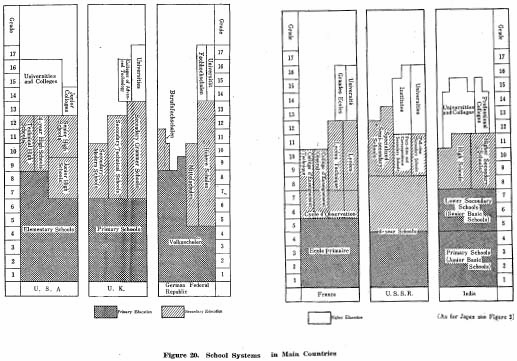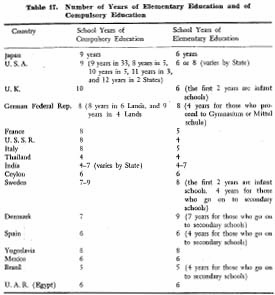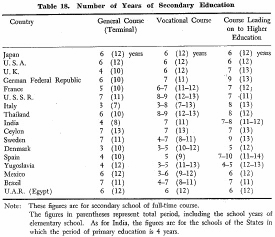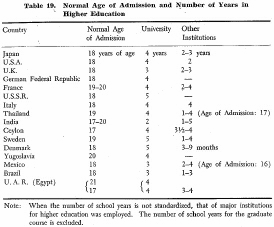| Home > Policy > White Paper, Notice, Announcement > White Paper > JAPAN'S GROWTH AND EDUCATION 1963 > CHAPTER |
||
The organizational structure of elementary, secondary and higher education in Japan and other countries is indicative of national educational objectives. The following figure and tables are illustrative.
The U.S.A. has a single-truck school system open to all from the primary school through the university. Japan has an educational system of almost the same pattern. In other countries, the double-truck system still obtains, under which specialization in separate schools for professional education begins either in the upper level of elementary education or at the secondary education level.
In the German Federal Republic, pupils completing the fourth grade (at 10 years of age) are divided into two groups; one to continue elementary school education and the other to proceed to junior high school. Those who enter junior high school are chosen through examinations or 'Prove-unterricht' (trial) classes. The Educational Reform Plan in 1959 provided that the first two-year course of junior high school is devoted to the observation of pupils' aptitudes and counseling as to the selection of advanced courses.
In France, the same division of pupils into two groups is made when pupils reach 11 years of age, i.e., the end of the 5th grade of elementary school. Pupils who proceed to junior high school are chosen by tests from among those who desire to do so. The system of using the first two junior high school years for the observation of pupils' aptitude as proposed in the Educational Reform Plan in 1959 in West Germany has already been set up in the country; pupils finishing the two-year schooling in junior high school are guided, in accordance with the ability and aptitude, to follow the course for higher education or that of one of several terminal courses of less than higher education level.
Under the British system, pupils who have finished 6 years of elementary education are all given tests to determine, on the basis of individual ability and aptitude, eligibility for admission to the three types of secondary school: the secondary grammar school, which is the basic college-preparatory school; the secondary technical school; or the secondary modern school, for general terminal education.
In the U.S.S.R., the eight years of elementary education are common to all. Pupils who graduate from the eighth grade with satisfactory examination grades, are permitted to enroll in one of three types of secondary schools: the full-time college-preparatory secondary school; the secondary school of general education, for those who will work in factories or on farms, conducted mainly in the evening or through correspondence; or the secondary semi-professional school. Admission to the latter is by entrance examination only.
In the U.S.A., there is no separate 'track' for students aspiring to higher education. The upper secondary school in the country are mostly of the comprehensive type. Students mad' elect college-preparatory, vocational and general terminal program according to their desire and guidance.
The school systems of India vary among the individual states. That of Maharashitra State, which is comparatively large, has been taken as an example, but, probably because education is still underdeveloped, the differentiation of secondary education is not yet very filmy established. The upper secondary school of Japan is similar to that of the U.S.A., but the numbers of specialized college-preparator3z and technical or vocational schools are increasing in comparison with those in the U.S.A. Admission to public upper secondary schools is by prefectural examination. A new technical college with a 5-year course was established in 1962 as one measure to promote scientific and technical education. This 5-year course corresponds to grades 1O~14.
Table 17 shows the number of years of the elementary school curriculum and the number of years of compulsory education in Japan and in other countries.


As shown in this table, compulsory education extends beyond the standard level of elementary education in the countries advanced in economic and social development. While in true less developed countries, the school years of compulsory education are shorter, and its educational contents are not satisfactory in those countries.
Japan belongs to the group of countries with longer school years of compulsory education, which shows that the national standard of education is fairly high.
Table 18 shows the number of years of secondary education and the total number of years of elementary and secondary education in the general and vocational terminal secondary schools and college-preparatory schools in the various countries at present.

In most countries listed, the college-preparatory course is the longest of the three types of secondary school courses.
Disparities between advanced and developing countries in the length of college-preparatory secondary school courses are not as great as those in the length of the periods of elementary education and compulsory education. This is probably an indication of common effort by nearly all developing countries to provide secondary education for the select portion of the population for whom the secondary schools are intended.

Variances among countries in the normal age of admission to higher education and in the number of years of undergraduate curricula are slight, even though the objectives and character of higher education differ widely.
The foregoing is a brief comparative analysis of the organization of national educational systems. It has been shown that the length of the period of compulsory education is closely related to the socio-economic development of nations, i.e., the more advanced nations tend to have the longer period of compulsory education. Similarly, the more advanced nations tend to postpone to some extent specialization of curricula and segregation of students according to educational objectives. Debate as to the desirability of this trend is not as important, however, as is the need for developing techniques, procedures and time for the evaluation of student abilities and aptitudes and the guidance and counseling of students in the selection and pursuit of appropriate curricula.
| Back to Top | MEXT HOME |